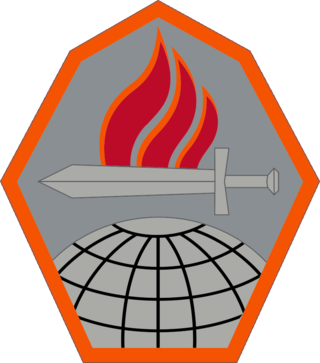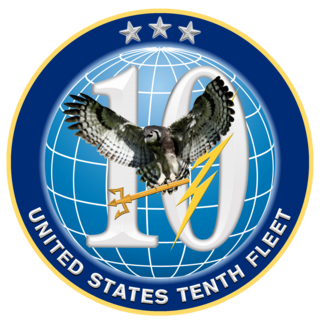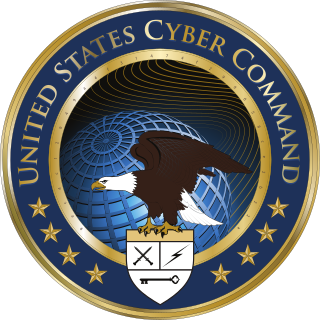
Fort Gordon, formerly known as Camp Gordon, is a United States Army installation established in October 1941. It is the current home of the United States Army Signal Corps, United States Army Cyber Command, and the Cyber Center of Excellence. It was once the home of The Provost Marshal General School and Civil Affairs School. The fort is located southwest of Augusta, Georgia. One of the major components of the installation is Advanced Individual Training for Signal Corps military occupational specialties. Signals Intelligence has become more visible and comprises more and more of the fort's duties. The installation was recommended for renaming to Fort Eisenhower by The Naming Commission. On 5 January 2023 William A. LaPlante, US under-secretary of defense for acquisition and sustainment directed the full implementation of the recommendations of the Naming Commission, DoD-wide.

Cyberwarfare is the use of cyber attacks against an enemy state, causing comparable harm to actual warfare and/or disrupting vital computer systems. Some intended outcomes could be espionage, sabotage, propaganda, manipulation or economic warfare.

The Cyberspace Capabilities Center (CCC), located at Scott Air Force Base, Illinois, is the primary organization that develops cyber domain requirements in the United States Air Force.

The 67th Cyberspace Operations Group is a unit of the 67th Cyberspace Wing. Headquartered on Kelly Field Annex's Security Hill, the group is an Air Force information operations unit.
A cyber force is a military branch of a nation's armed forces that conducts military operations in cyberspace and cyberwarfare. The world's first independent cyber force was the People's Liberation Army Strategic Support Force, which was established in 2015 and also serves as China's space force. As of 2022, the world's only independent cyber forces are the PLA Strategic Support Force, the German Cyber and Information Domain Service, and the Singapore Digital and Intelligence Service.

Twenty-Fourth Air Force / Air Forces Cyber (AFCYBER) was a Numbered Air Force within the United States Air Force. The Air Force consolidated its cyberspace combat and support forces into 24 AF. 24 AF was the Air Force component of U.S. Cyber Command.

The U.S. Tenth Fleet is a functional formation and a numbered fleet in the United States Navy. It was first created as an anti-submarine warfare coordinating organization during the Battle of the Atlantic in the Second World War. It was reactivated as a force provider for Fleet Cyber Command on 29 January 2010. U.S. Tenth Fleet serves as the numbered fleet for U.S. Fleet Cyber Command and exercises operational control of assigned naval forces to coordinate with other naval, coalition and Joint Task Forces to execute the full spectrum of cyber, electronic warfare, information operations, and signal intelligence capabilities and missions across the cyber, electromagnetic, and space domains.
Proactive cyber defence means acting in anticipation to oppose an attack through cyber and cognitive domains. Proactive cyber defence can be understood as options between offensive and defensive measures. It includes interdicting, disrupting or deterring an attack or a threat's preparation to attack, either pre-emptively or in self-defence. Common methods include cyber deception, attribution, threat hunting and adversarial pursuit. The mission of the pre-emptive and proactive operations is to conduct aggressive interception and disruption activities against an adversary using: psychological operations, managed information dissemination, precision targeting, information warfare operations, computer network exploitation, and other active threat reduction measures. The proactive defense strategy is meant to improve information collection by stimulating reactions of the threat agents and to provide strike options as well as to enhance operational preparation of the real or virtual battlespace. Proactive cyber defence can be a measure for detecting and obtaining information before a cyber attack, or it can also be impending cyber operation and be determining the origin of an operation that involves launching a pre-emptive, preventive, or cyber counter-operation.

United States Cyber Command (USCYBERCOM) is one of the eleven unified combatant commands of the United States Department of Defense (DoD). It unifies the direction of cyberspace operations, strengthens DoD cyberspace capabilities, and integrates and bolsters DoD's cyber expertise.

The 318th Cyberspace Operations Group is a United States Air Force information operations unit located at Joint Base San Antonio, Texas. The group was first activated during World War II as the 8th Photographic Reconnaissance Group. After training in the United States, the unit moved to the China-Burma-India Theater and engaged in hostilities until the end of the war. It returned to the United States in November 1945, and was inactivated at the port of embarkation.

U.S. Army Cyber Command (ARCYBER) conducts information dominance and cyberspace operations as the Army service component command of United States Cyber Command.
Cyberwarfare is the use of computer technology to disrupt the activities of a state or organization, especially the deliberate attacking of information systems for strategic or military purposes. As a major developed economy, the United States is highly dependent on the Internet and therefore greatly exposed to cyber attacks. At the same time, the United States has substantial capabilities in both defense and power projection thanks to comparatively advanced technology and a large military budget. Cyber warfare presents a growing threat to physical systems and infrastructures that are linked to the internet. Malicious hacking from domestic or foreign enemies remains a constant threat to the United States. In response to these growing threats, the United States has developed significant cyber capabilities.

The U.S. Marine Corps Forces Cyberspace Command is a functional formation of the United States Marine Corps to protect critical infrastructure from cyberattack. Marine Corps Forces Cyberspace Command is the Marine Corps component to U.S. Cyber Command. It comprises a command element, the Marine Corps Cyber Operations Group, and the Marine Corps Cyber Warfare Group, a total of approximately 800 personnel. MARFORCYBER was established on January 21, 2010 under the command of LtGen George J. Flynn,. As of 7 July 2021, MajGen Ryan P. Heritage is in command.

The military-digital complex (MDC) is the militarization of cyber operations by governments and corporations, often through monetary relationships between computer programmers in private companies and the military to combat the threat of cyber terrorism and warfare. Cyber operations since 2000 have increased dramatically, with the recent branch of the US Strategic Command the United States Cyber Command. Cyber operations has been defined by the Washington Post as,

The U.S. Fleet Cyber Command is an operating force of the United States Navy responsible for the Navy's information network operations, offensive and defensive cyber operations, space operations and signals intelligence. It was created in January 2010 "to deter and defeat aggression and to ensure freedom of action to achieve military objectives in and through cyberspace". U.S. Tenth Fleet was simultaneously reactivated as its force provider. Since it was founded, the command has grown into an operational force composed of more than 16,000 active and reserve sailors and civilians organized into 27 active commands, 40 Cyber Mission Force units, and 27 reserve commands around the world.

The Cyberspace Administration of China is the central internet regulator, censor, oversight, and control agency for the People's Republic of China. Under the arrangement "one institution with two names", it is the external brand name of the Office of the Central Cyberspace Affairs Commission of the Chinese Communist Party.

Paul Miki Nakasone is a four-star general in the United States Army who serves as the commander of United States Cyber Command. He serves concurrently as the director of the National Security Agency and as chief of the Central Security Service. Nakasone took command of the United States Second Army and Army Cyber Command in October 2016, until the Second Army's inactivation in March 2017. In May 2018, he became head of the National Security Agency, the Central Security Service and the United States Cyber Command.

The Joint Cyberspace Command (MCCE), known until 2020 as Joint Cyber-Defence Command (MCCD), is a Spanish cyberspace service of the Defence Staff responsible for planning and carrying out he actions related to cyber defence in networks and information and telecommunications systems of the Ministry of Defense or others that might be entrusted, as well as contributing to the adequate response in cyberspace to threats or aggressions that may affect to the National Defense.

Cyberwarfare is a component of the confrontation between Russia and Ukraine since the collapse of the Soviet Union in 1991. While the first attacks on information systems of private enterprises and state institutions of Ukraine were recorded during mass protests in 2013, Russian cyberweapon Uroburos had been around since 2005. Russian cyberwarfare continued with the 2015 Ukraine power grid hack at Christmas 2015 and again in 2016, paralysis of the State Treasury of Ukraine in December 2016, a Mass hacker supply-chain attack in June 2017 and attacks on Ukrainian government websites in January 2022.
















